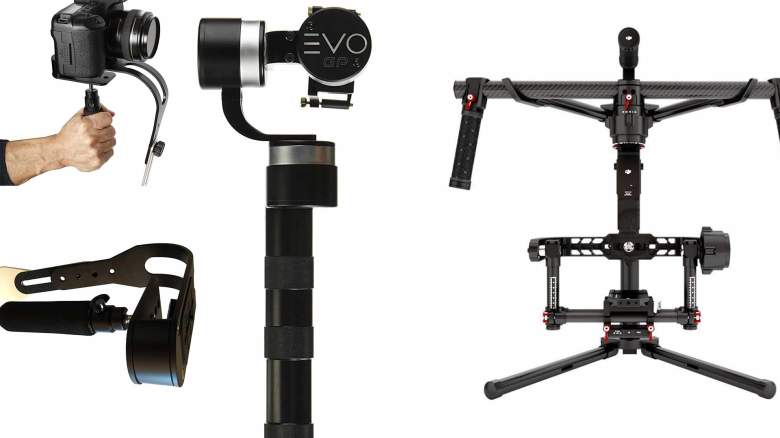
Gimbal stabilizers allow users to take almost any camera and shoot beautiful, moving footage. For many years, gimbals were something only accessible to the budgets of Hollywood or at the very least, professional videographers or studios. The good news is that over time, prices have dropped significantly, allowing prosumers and even consumers to afford these useful tools.
This list covers the best of the best for DSLRs, smartphones, and larger cameras in a variety of price ranges. Whether your budget is $1,000 or $100, one can immensely improve the quality of their shots and footage using stabilizers.
If you’re looking for the best gimbal stabilizers for DSLRs, check out our dedicated list. For a more affordable stabilization option, check out the best shoulder rigs.
All that out of the way, here are the best 3-axis gimbal stabilizers available now.
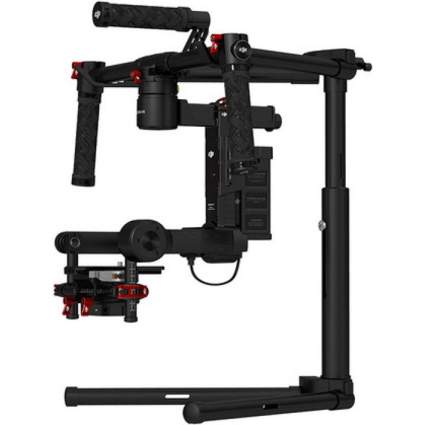
|
Amazon Customer Reviews
|
Price: $799.00 Shop at Amazon | Shop now Read our review |
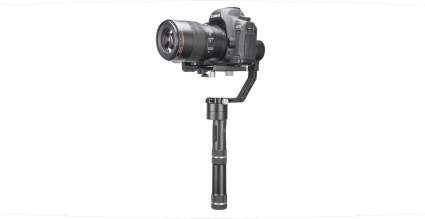
|
Amazon Customer Reviews
|
Price: $579.00 Shop at Amazon | Shop now Read our review |
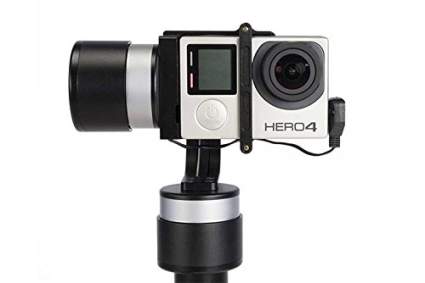
|
Amazon Customer Reviews
|
Price: $169.95 Shop at Amazon | Shop now Read our review |
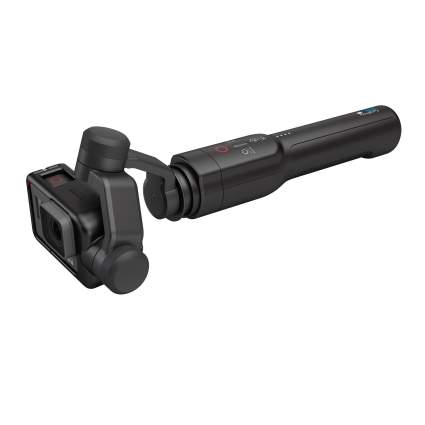
|
Amazon Customer Reviews
|
Price: $299.99 Shop at Amazon | Shop now Read our review |
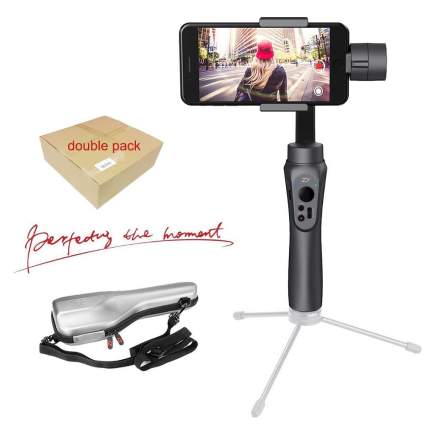
|
Amazon Customer Reviews
|
Price: $989.00 Shop at Amazon | Shop now Read our review |

|
Amazon Customer Reviews
|
Price: $179.99 Shop at Amazon | Shop now Read our review |
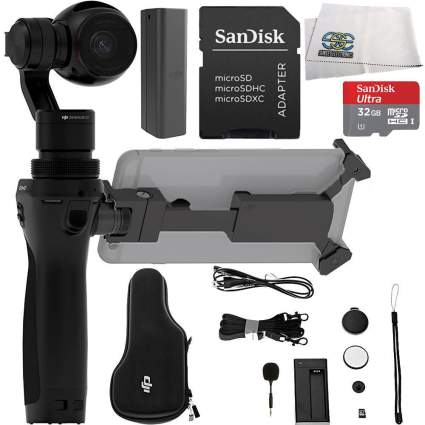
|
Amazon Customer Reviews
|
Price: $629.00 Shop at Amazon | Shop now Read our review |
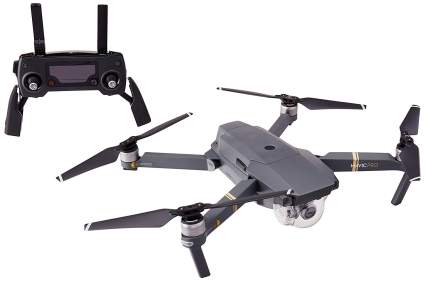
|
Amazon Customer Reviews
|
Price: $1,999.00 Shop at Amazon | Shop now Read our review |
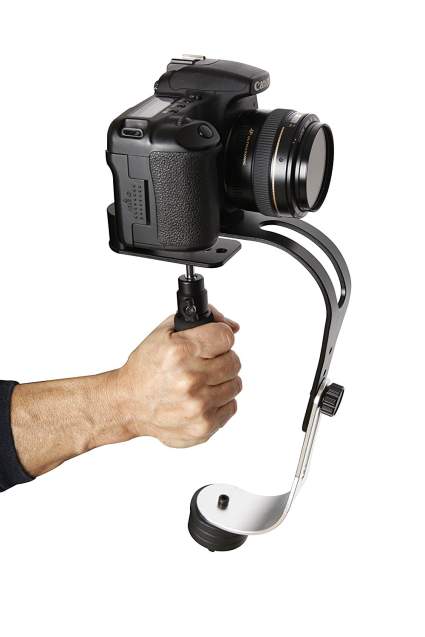
|
Amazon Customer Reviews
|
Price: $49.99 Shop at Amazon | Shop now Read our review |
-
1. DJI Ronin-M 3-Axis Gimbal Stabilizer v3 (Best all-around)
Pros:- Praised as sturdy and solid piece of equipment
- A must for wedding and event videographers
- Drastically improves video quality
- Can be set down and used to take smooth, fixed pans and tilts with a remote
- Adds professional, cinematic look to footage and allows one to use prosumer cameras
Cons:- Balancing gimbal takes time (between three and ten minutes) and some technical understanding
- Overkill for many users
- It can struggle with heavier cameras, or at least be very tough to balance (one example is an FS5 with a large lens)
- Some users report issues with drifting
This is the successor to the revolutionary stabilizer that started the affordable gimbal market, and it’s a huge improvement in every way to that initial revolution. It’s significantly lighter, faster, and easier to set up than the original Ronin. The footage speaks for itself: if one is shooting a wedding or similarly produced event, the Ronin-M adds a wonderful, smooth panning and gliding effect to every and any shot it’s used in.
That said, even if you’re a casual filmmaker who can afford the Ronin-M, know that it’s not exactly effortless to set up. It requires calibration, practice, and after getting a handle of the actual stabilizer, focusing one’s camera can still to be challenging. There are a variety of ways to attack the focus problem, one can see some solutions in this video by Youtuber Michael Ronin. Few cameras have great autofocus in video, but there are still a few ways to mitigate this problem including staying a fixed distance from your subject, shooting at a high aperture (meaning everything is in focus), and using a wireless follow focus system (Browse Amazon for top-rated wireless follow focus systems).
While this is a tool that isn’t exactly easy to use, if one learns the skills, it permits users to capture Hollywood quality panning, tilting, and tracking footage at an extremely affordable price. It’s also compatible with a wide array of devices and weights (up to eight pounds). The Ronin-M is the gold standard and a must for wedding videographers and anyone looking to capture stabilized footage with a DSLR, mirrorless, or camcorder. You may also wish to check out the Ronin-S, a model oriented toward one-handed use and $100 cheaper (great for small rigs).
Find more Ronin-M 3-Axis Gimbal Stabilizer information and reviews here.
-
2. Zhiyun Crane 3S (Best for mirrorless, light cameras)
Pros:- Camera focus and shutter speed can be adjusted using gimbal
- Most affordable gimbal for mirrorless cameras
- Includes two batteries for 12 hours of battery life (according to manufacturer)
- Bottom of handle has a 1/4″ screw thread so it can be mounted to tripods, monopods
- 4 modes for various shooting options
- Includes hard carrying case
Cons:- Some cameras are impossible to balance or too heavy
- Not good enough to counteract walking movement
- Some users had issues with customer service
Zhiyun has yet to make itself an established brand name in the gimbal space, but they’re definitely making a splash. Boasting a much smaller profile than anything like a Ronin, the Zhiyun lives in the middle ground, where one can easily transport it, and use it handheld for long durations of time. That said, it’s still somewhat complicated and requires 5-10 minutes of initial balancing for some users. The other disadvantage is that some people had issues with their customer service after getting a bad unit. Still, if one can look past these issues and onto the perks, the Zhiyun offers a great, convenient setup for using your mirrorless camera with excellent stability at a much cheaper price than a Ronin-M.
Capacity: 1200 grams (1800 grams after firmware update) | Batteries: 2 batteries included (Manufacturer claims 12 hour lifetime) | Weight: less than 2lbs | Mount: Standard tripod plate (quick mount) | Camera Type: Light mirrorless, DSLR, or any camera on a plate | Warranty: 30 day satisfaction guarantee (10% restocking fee, via manufacturer)
Find more Zhiyun Crane information and reviews here.
-
3. Evo GP 3 (Best for GoPro 3)
Pros:- Built-in charging capable of extending GoPro’s battery life
- Multiple shooting modes such as heading follow, heading lock, head/pitch, and inverted
- Pan button turns GoPro in multiple directions
- Solid design, steady and stable motion
- Replacement batteries are cheap and readily available
- Motor praised as silent
Cons:- Not compatible with GoPro Hero 5 or waterproof case
- Some users complained that motors were noisy, ruining audio
- Movements can be hard to get used to
The Evo GP3 is loved by reviewers and GoPro owners. Surprisingly, GoPro has failed to deliver in two key areas: drones and to some extent gimbals. No matter, competitors have filled the space and the Evo GP3 is not only slightly cheaper, it works with the GoPro 3 and 4, unlike the Karma Grip, which excludes GoPro 3 owners. If you’re between the Evo and the Karma, the Karma’s motor is reported as more quiet. The GP3, however, is cheaper and many users report an excellent experience, including its ability to charge a GoPro while stabilizing it. Another big advantage is that compared to the GoPro Karma, this gimbal allows one to swap out batteries. It includes two, but it also allows one to purchase additional batteries. If you’re GoPro Karma dies, you’re pretty much SOL for around six hours while its internal battery charges (one can’t change the battery on a Karma).
Capacity: Up to 155 grams (will work with LCD backpack or backpack accessory) | Battery Life: 2 batteries included, total of 5 hours | Weight: 1.4lbs | Camera Type: GoPro Hero 3, 3+, 4, some other action cameras | Warranty: 1 year
Find more Evo GP 3 information and reviews here.
-
4. GoPro Karma Grip
Pros:- Super simple camera controls
- Compatible with GoPro Hero 5
- Quiet motor functioning
- Better brand name and customer service than GP3
Cons:- Doesn’t work for GoPro Hero 3
- Some users claimed that footage was shaky
- A few users had issues with reliability
GoPro’s answer to the stabilizing gimbal is its Karma Grip. While GoPro was plagued with issues with its Karma drone, its grip has fared much better. The main advantage against the Evo GP3 above is its compatibility with the GoPro Hero 5. It also has considerably more quiet motor functioning, meaning one should be able to get cleaner audio. There are some drawbacks, however, namely the lack of a swappable battery. The Karma Grip’s internal battery cannot be swapped out. Therefore, once the Karma Grip’s short battery life withers away after (at best) an hour and 45 minutes, one will be stuck waiting for it to recharge. Bummer, but then again, it’s not that short an amount of time. Still, if one foresees this as an issue and doesn’t have a GroPro Hero 5, the GP3 may prove a better (if noisier) option.
Battery Life: 1 hour and 45 minutes | Weight: 2.5lbs | Warranty: 1 year
Find more GoPro Karma Grip information and reviews here.
-
5. Zhiyun Smooth-Q (Best value gimbal for smart phones)
Pros:- Excellent stabilization of wide variety of smartphones
- Fantastic battery life
- Decently weatherproof
Cons:- App barely works
- Setup can be challenging
- Battery charger LED can be off or non-indicative of charge level
For those who want a solid smartphone gimbal at a low price, this Zhiyun model offers a ton of value. While it lacks the fancy app features of the Osmo Mobile, it does a great job of doing what a stabilizer needs to do: keeping things steady and level. Don’t expect any of the advanced features like “Follow me” to deliver, but for the most part, these features are gimmicky and not for filmmaking anyway.
This is a great gimbal for people who just want to stabilize their phone without any fancy app features or abilities. At this price, it’s a superb value.
Capacity: 220 grams | Battery Life: 12 hours | Weight: 450 grams | Mounting: Can mount to tripod
Find more Zhiyun Smooth-Q stabilizer information and reviews here.
-
6. Osmo Mobile 2 (Best for smartphones)
Pros:- Motion time-lapses, light trails, and various other shooting options in robust DJI Go app
- Active track technology lets the Osmo Mobile watch one’s face for a video selfie
- Includes soft carrying case
- Most affordable option
Cons:- Phone batteries can die quickly and iPhones use internal batteries, can be mitigated by charging a phone while in Osmo
- Some limitations in DJI Go app for Android users
- Some users had issues with customer service
For those looking to use their smartphone camera, the Osmo Mobile 2 offers an affordable and high quality stabilizing solution. The Osmo clamps onto one’s phone and has a very simple set-up. Usually, it works upon extending the arm just the right amount– so it’s literally configured in seconds. Footage can be anywhere from OK to outstanding, depending on your phone’s capability and the time of day (most phones can’t handle low light at all). The Osmo Mobile is great for a variety of users, and with certain apps and high-quality smartphones, it certainly allows one to achieve high quality, stabilized footage.
While this model is great for whizzing around and getting steady footage, don’t expect too much from the app; it’s still buggy. Get it right, DJI! Nonetheless, with the easy controls and some “dancing” you can easily get the shots you want, just don’t expect too much functionality with direct integration to the gimbal.
Capacity: Works with phones as large iPhone 8+ | Battery Life: 15 hours total | Weight: 485g | Mounting: Clamps to phone | Camera Type: Smartphone | Warranty: Depends on part, but usually one year
Find more Osmo Mobile information and reviews here.
-
7. Osmo 4k Camera Bundle
Pros:- Easy setup
- 4K camera works great in daylight
- Picture quality is praised as great, shots are extremely smooth
- Easiest gimbal to setup, no balancing issues
- Camera can be used remotely over Wi-fi
- Includes SD card
Cons:- Many users suggest one needs extra batteries
- Extremely wide field of view not preferable for some shots, Osmo+ can zoom in, but has host of other issues (see on Amazon)
- Lowlight shots are noisy
- Audio is dicey, one will need an external solution
The Osmo 4k stabilized camera offers one the most set-up free gimbal experience possible. It boasts 4K footage and solid stills at 12 megapixels raw. One issue with this camera is the field of view is on the wide side, leading to more of a GoPro or action camera kind of vibe. Nonetheless, it’s a lot of fun and for users looking to capture moving footage that doesn’t need to be quite cinematic in quality, the Osmo 4k camera offers unique value and simplicity.
Capacity: N/A | Battery Life: 90 minutes | Weight: .44lbs | Mounting: Smartphone mounts to Osmo | Camera Type: Built-in camera | Warranty: Depends on part, but usually one year
Find more Osmo 4k Camera Bundle information and reviews here.
-
8. Mavic Pro
Pros:- One of the best drones on the market
- Decent stabilization and footage from the onboard camera
- One can use drones for inaccessible panning and/or movement shots
- Folds to be very small
Cons:- Camera isn’t great for indoor shots
- Camera is limited to one lens
- Overpriced for most who only need a gimbal
- Does not let one use external camera
Wait, isn’t the Mavic Pro a drone? Yes, yes it is. But believe it or not, if you’re in the market for a drone and stabilizer, and you’re looking for a particular kind of footage, the Mavic Pro can be an all-in-one solution. Using the PolarPro Katana one can wield the body of their Mavic Pro like a nice handheld camera. It’s an unconventional solution, but let’s be honest: drones are awesome. If one is in the market for both and doesn’t need the footage from their stabilizers to be cinema quality (the Mavic Pro’s camera is good for action footage and the like, but it falters in low light), this can be a fun and interesting option.
Capacity: N/A | Battery Life: 30-minute flights, unknown gimbal performance time | Mounting: Mounts to PolarPro Katana | Camera Type: Drone camera, struggles in lowlight | Warranty: 6 months for gimbal camera via DJI
Find more Mavic Pro information and reviews here.
-
9. Roxant Pro Handheld Stabilizer (Best value)
Pros:- Compatible with GoPro, DSLR, mirrorless cameras, and point and shoot
- Lifetime support from Roxant
- Users report it as easy to balance
- Unique design reduces fatigue according to manufacturer
- Users praise it as affordable, effective, and fast to setup
Cons:- Some users say it only works best when hacked
- One user said that gimbal did not provide stability at all
- A few users report durability issues
The Roxant Pro is the budget option, but make no mistake, while it’s cheap and requires some skill, it doesn’t have to be a huge compromise. Sure, on average, one’s footage using this device won’t be as smooth as with a gimbal stabilizer like the Ronin-M, but it’s still a dramatic improvement. Another advantage is that since it’s handheld, one is able to adjust the focus, since the camera is within arm’s reach.
Users report that it’s easy to balance and surprisingly simple to learn. Another unique perk that one won’t find in gimbal land: the Roxant is simple to set up. Of course, there are users who claim the device performs much better when “hacked,” but this is still only a one-time setup. The Ronin-M, for instance, generally requires calibration with each use, as it can be drifty, even once you have a consistent camera/lens setup. Users report it takes between five and ten minutes to do this. The Roxant takes practice and skill, but if one can’t afford a pricier stabilizer, it will be a rewarding challenge- one that has pleased many users.
Capacity: 2.1lbs | Battery Life: N/A | Weight: 1.8lbs | Camera Type: Light to medium weight rigs | Warranty: Lifetime support
Find more Roxant Pro Handheld Stabilizer information and reviews here.